Piano Chord Voicing
Close Voicing - Open Voicing
Piano Chord Voicing:
"In music composition and arranging, voicing is the vertical spacing and ordering of the notes in a chord (which notes are on the top, middle and bottom and which octave each is in). Which note is on the bottom determines the inversion." From Wikipedia, the free encyclopedia.
In close position (or close voicing) the chord notes are stacked within an octave, usually in 3rds. In open position (or open voicing) the chord notes are spread greater than an octave. The bottom interval is usually a 5th, 6th or octave.
Here are 2 examples:
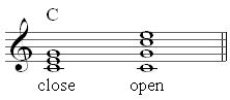
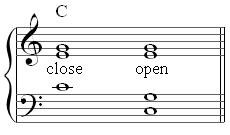
Both of the above are C triads in root position (the root is the bass note.) The 1st chord is close position: root - 3rd - 5th
The 2nd chord is open position: root-5th-root-3rd and root-5th-3rd-5th
There are many ways to voice a chord, as the examples below will show. Piano chord voicing is MOST OFTEN divided between both hands. The left hand usually covers a 5th, octave and sometimes a 10th - the right hand usually has smaller intervals.
When playing from a LEAD SHEET or FAKE BOOK, the right hand also usually keeps the melody note on top!
Below is a broken C chord: 5th-root-3rd-5th-5th-3rd-root-5th:

Here is that same broken chord harmonized in close voicing in the right hand:

Here is that same broken chord harmonized in open voicing. The notes are spread between both hands.
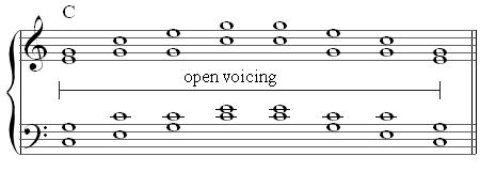
Now, here is that same broken chord treated a little differently. The right hand is played with close voicing while the left hand plays a pedal-point bass on an octave C.
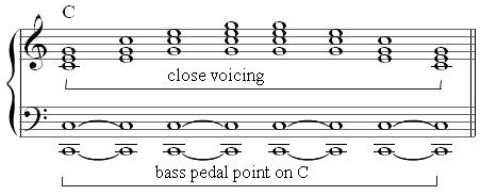
Any one of the above examples is OK. Each version is played differently and sounds different.... but they are all OK!
Next is a melody in the right hand and the chord played in close voicing in the left hand.
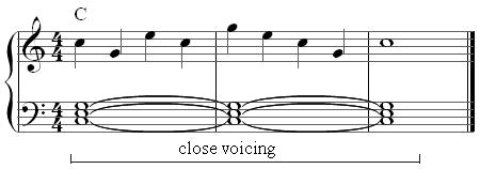
Here is that same melody with the chord in open voicing. The chord is spread between the left hand and the thumb of the right hand.
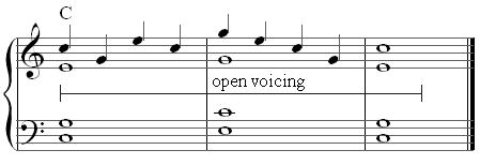
Piano chord voicing follows some basic guidelines when playing from a lead sheet or fake book:
- the melody note is usually on top
- avoid doubling the 3rd, especially if the 3rd is the bass note
- the intervals between the inner voices shouldn't be more than an octave
- the inner voices move smoothly from note to note
(Go here for a 2 note voicing of a 12 bar blues)
Turnaround Voicings (key of F)
When we looked at "Georgia On My Mind" on the turnaround page, remember the turnaround in measures 7 & 8? That chord progression was
Am7-Ab7-Gm7-C7#5 (iii7-bIII7-ii7-V7#5.)
Using some substitute chords and different voicings, here are five different versions of that same turnaround. The first is:
Fmaj7-Dm7-Gm7-C7#5 (Imaj7-vi7-ii7-V7#5)

Fmaj7-F#dim-Gm7-C7#5 (Imaj7-#iidim-ii7-V7#5)

Fmaj7-Am7-Bbmaj7-C7#5(b9) (Imaj7-iii7-IVmaj7-V7#5(b9))

Fmaj7-Am7-Bbmaj7-C7#5(b9) (Imaj7-iii7-IVmaj7-V7#5(b9))
This is the same progression, but notice how the piano chord voicing is different.

Am7-Ab13-Gm7-Gb9(b9) (iii7-bIII(13)-ii7-bII(9))
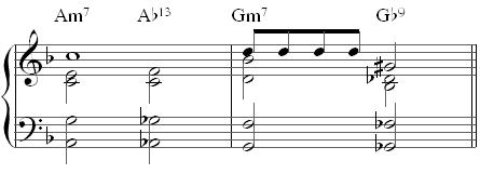

THE COMPLETE
ONLINE BUSINESS BUILDER
SBI
Hi and Welcome!
Fill out the form below to sign up for the free periodic
Player's Guide Newsletter!
Get tips and ideas about substitute chords, chord progressions and harmonic movement.
What's this???
The Complete book of:
Scales, Chords,
Arpeggios & Cadences
Harmony and Theory:
by Carl Schroeder and Keith Wyatt






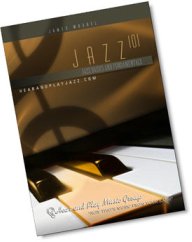



New! Comments
Please leave me a comment in the box below.